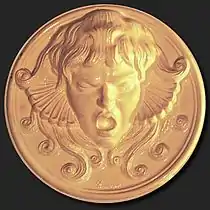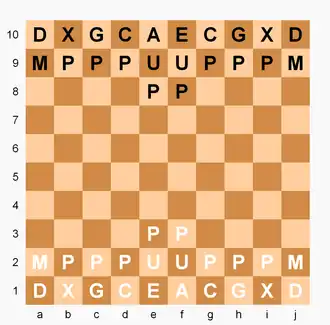
2000 A.D. is a chess variant created by V. R. Parton which employs fairy chess pieces on a 10×10 board.[1][2] Parton published the variant in his 1972 monograph My Game for 2000 A.D. and After.
Description
Parton describes his invention as "the game for Future Players in the Next Millennium", feeling that to be sufficiently challenging for later generations a variant should possess a larger board and increased possibilities. The distinction between moving and capturing methods of most of the pieces is a feature characteristic of the game.[lower-alpha 1]
The Gorgon, Ximaera (Chimaera), and Fury are all terrifying female monsters from Greek mythology. The Dragon is also referred to by Parton as female (Parton 1974:19). The Attendant stands next to the Empress at the beginning of the game and moves as a chess king, but is stripped of all normal royal powers.[lower-alpha 2]
Game rules

White moves first. Capturing the enemy Empress wins the game. There is no castling or checking in 2000 A.D.
Pieces that move and capture the same way
The following pieces capture the same as they move :
Empress (E)
- Moves as a chess queen;
- If captured the game is over.
Attendant (A)
- Moves as a chess king without royal powers.
Unicorn (U)
Pawn (P)
Pieces that move as a queen but have other power
The following pieces move as a chess queen, but capture (or exercise other power) in their own special ways:
Capricorn (C)
- Captures by charging (moving to a vacant square orthogonally or diagonally adjacent to) an enemy piece;
- Can capture up to seven pieces in one turn, if they are all adjacent to the square the Capricorn charges to.
- A Capricorn has the ability to capture Gorgons.
Gorgon (G)
- Captures as a chess queen;
- Petrifies (immobilizes) any enemy piece it attacks;
- If petrified by an enemy Gorgon, does not lose its power to petrify other pieces;
- A Gorgon can be captured only by a Unicorn or a Capricorn.
Ximaera (X)
- Cannot capture but is subject to capture;
- Swaps places with any enemy piece it attacks;
- If swapped with an enemy Ximaera, the player may reverse-swap them, but not on his next turn.
Dragon (D)
- Captures by leaping an enemy piece to any vacant square immediately beyond it;
- Can make multiple captures in a single turn in the same direction;
- In a multiple capture, a Dragon is immobilized after one of the captures, if a Gorgon attacks it.
Mimotaur (M)
- The Mimotaur[lower-alpha 3] (presumably a Minotaur that mimics)[1] captures in the same manner as the piece being captured;[3]
- Counter-petrifies an enemy Gorgon;
- Can swap places with an enemy Ximaera;
- A Mimotaur is incapable of attacking another Mimotaur;
- Must be adjacent to the Attendant to capture it;
- Must be in front of and adjacent to a pawn to capture it.
Alternate piece
The following is an alternate piece; if used, Furies replace Gorgons in the starting position:
Fury (F)
- Combines the powers of all the other pieces "[...] into one Supreme Terror" (Parton 1974:22).
See also
Notes
- ↑ "The feature of the game, possibly inspired by Ultima, is that all the major pieces move as a queen but each has its own method of capture."[1]
- ↑ Capturable and the weakest of the non-pawn pieces, the Attendant probably best "serves as a screen for the empress".[1]
- ↑ "The Mimotaur (the spelling is correct as the name of this Fury monster) [...]"[3]
References
- 1 2 3 4 Pritchard (1994), p. 328
- ↑ Pritchard (2007), pp. 157–58
- 1 2 Parton (1974), p. 21
Bibliography
- Parton, V. R. (1972). My Game for 2000 A.D. and After. WorldCat. p. 12. OCLC 57502218.
- Parton, V. R. (1974). Chessery for Duffer and Master. Amazon. pp. 19–23. ASIN B0007C9VCY.
- Pritchard, D. B. (1994). The Encyclopedia of Chess Variants. Games & Puzzles Publications. ISBN 0-9524142-0-1.
- Pritchard, D. B. (2007). Beasley, John (ed.). The Classified Encyclopedia of Chess Variants. John Beasley. ISBN 978-0-9555168-0-1.